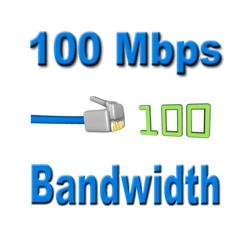For many mid-size businesses, DS3 internet with its 45 Mbps speed has been the standard. It’s widely available and offered a significant upgrade from older T1 lines. However, with the rise of video conferencing and cloud-based applications, even DS3 struggles to handle the demands of multiple users. It’s time to consider upgrading to 100 Mbps internet access.
The 100 Mbps service level is significant because it aligns with “Fast” Ethernet, a standard Ethernet LAN speed. Most network interface cards (NICs) in computers, routers, switches, and printers support 10/100 Mbps Ethernet speeds. Newer NICs even support Gigabit Ethernet (GigE) with 10/100/1000 Mbps ports.
The issue is that connecting to the internet at a slower speed than your 100 Mbps LAN will cause a bottleneck for internet traffic. While this might not be noticeable during low network activity, congestion becomes apparent with multiple users and heavy data usage. The connection to the internet, often the WAN or wide area network, becomes the chokepoint.
Fortunately, 100 Mbps business internet service is now more accessible and affordable than ever. Let’s explore the various technical approaches and their pros and cons.
OC-3, a traditional 100 Mbps telecom service, operates at around 155 Mbps. Offered by telecom companies nationwide, OC-3 is a fiber optic SONET service. It can transport various data types, including phone calls, private connections, and dedicated internet access. OC-3 is also used to deliver lower-speed services like DS3. While you might not associate DS3 with fiber optics due to its coaxial cable connections, it’s often delivered through add/drop multiplexers connected to SONET fiber cables.
OC-3 is a well-established and popular digital line service with an SLA (Service Level Agreement), ensuring reliability. Your bandwidth is both dedicated and symmetrical. Dedicated bandwidth means you don’t share the 155 Mbps with other users, ensuring consistent availability. Symmetrical bandwidth means you have 155 Mbps for both uploads and downloads.
Carrier Ethernet directly competes with OC-3 in bandwidth. Connecting to your LAN with Fast Ethernet at 100 Mbps is straightforward using a standard RJ-45 patch cable, eliminating the need for specialized fiber optic cables or interface cards required for OC-3. Like OC-3, 100 Mbps Fast Ethernet is symmetrical, dedicated, and comes with an SLA.
Fast Ethernet is available over both fiber optic and twisted-pair connections. However, Ethernet over Copper at this speed has distance limitations, making it more common in metropolitan areas. Slower speeds like 10 or 20 Mbps have a wider range and are more accessible.
Ethernet over Fiber, similar to OC-3, offers two key advantages. Firstly, the cost per Mbps is often lower than OC-3. Secondly, Carrier Ethernet services are scalable. While upgrading from OC-3 typically means moving to OC-12 at 622 Mbps, Carrier Ethernet offers more flexibility. With a Gigabit Ethernet port, you can easily upgrade to 200, 500, or even 1,000 Mbps as your needs grow.
Another increasingly available option is 100 Mbps Cable business broadband. This shared, asymmetrical service, similar to residential cable internet, typically lacks service level agreements. While it offers download speeds up to 100 Mbps, upload speeds are around 10 Mbps. This bandwidth is shared with other users, resulting in varying speeds, especially during peak hours. However, its affordability, often comparable to a T1 line, makes it suitable for businesses with limited budgets and basic internet needs.
If you’re considering new business internet service or upgrading from bonded T1 or DS3 to 100 Mbps or higher, now is the time to explore your options. Check 100 Mbps Internet pricing and availability for your business location. Complimentary consulting is available to help you navigate the choices.


